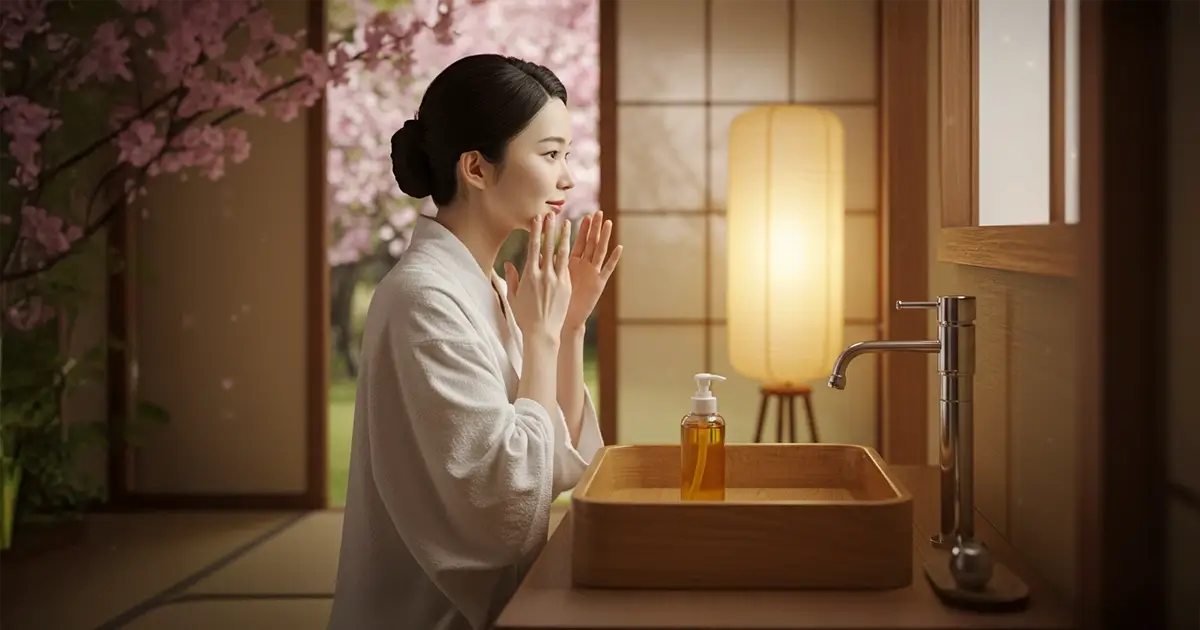Curious why so many Japanese skincare fans swear by washing twice? I unpack the centuries of tradition, the lab-tested science, and the exact routine that fits busy modern life, in this deep dive about double cleansing. Expect practical tips, calm-barrier wisdom, and gentle myth-busting in one read. 12-minute read
From Court Beauty to Global Staple: A Brief History
In ninth-century Heian Japan, noblewomen slept in lacquered chambers and painted their faces with oshiroi, a white rice powder paste. Oil-infused camellia seeds were massaged over the skin each evening so the powder would glide off without tearing fragile moisture defenses. That motion, repeated nightly, laid the groundwork for step one of double cleansing.
Move forward to the Edo period and merchants introduced nuka-bijin, a paste of rice bran and water. Women working in sake breweries noticed their hands looked remarkably soft, so they borrowed the ferment-rich wash for faces. The idea that one pass could purify while keeping tonal balance became central to community baths across Japan.
Twentieth-Century Reinvention
When tourism blossomed after World War II, visitors to Ginza department stores brought home balms stamped "oil cleanser first." Brands such as DHC exported the ritual along with green tea sweets. By the 1990s, international makeup artists praised the method backstage at Paris runways, cementing it as a global trend.
Today, Japanese formulators lean on emulsifiers that rinse clean with soft water, so step one leaves no greasy veil. Dermatologists worldwide now repeat the same guideline: fat-loving grime dissolves fastest in lipid-rich cleansers, while sweat and dust follow with a mild foaming wash.
The Science Behind Two Steps
I once tried explaining double cleansing to my engineer brother. He nodded then asked, "So, polarity magic?" Not far off. Step one relies on like-dissolves-like. The oil phase grabs sunscreen polymers, silicone foundation, and sebum, turning them into an easy-to-rinse emulsion.
A 2004 Journal of Dermatology study found that surfactants strip fewer proteins when paired with an initial lipid phase. The barrier recovery time shortened compared with foam-only cleansing. Translation: the skin feels flexible, not squeaky.
Why Oil First?
Plant oils carry triglycerides similar to those in our natural sebum, so the first massage drags dirt out of pores rather than forcing it deeper. Research on oleic-acid-rich formulas shows they loosen corneocyte bonds and allow water-based cleansers to sweep the path clean without friction.
Picking the Second Cleanser
The follow-up wash should be low pH, fragrance-light, and sulfate-free. Syndet bars and amino-acid gels excel here. According to a review of surfactant interactions, formulas under pH 6 keep ceramide loss minimal, so the skin's protein network stays intact.
Now, here's the fun part: foam density is far less important than fingertip pressure. A cloud of bubbles impresses your mirror, not your corneocytes. Save dramatic lather for shampoo commercials and use gentle circles instead.
How to Master Double Cleansing at Home
You only need two products and clean hands. A jade roller is optional; your knuckles are free.
- Dispense an oil or balm. Warm one teaspoon between palms. Think of the texture turning buttery, not molten lava.
- Massage thoroughly. Work from the center of the face outwards for sixty slow seconds, lifting along the jaw. Spoiler: it does not involve using your dishwasher.
- Add water to emulsify. Wet fingertips, then create a pale milk. Keep gentle - imagine painting watercolor, not scrubbing a stovetop.
- Rinse with lukewarm water. Hot water may feel luxurious, yet it strips intercellular lipids. Cool water can leave residue.
- Apply the water-based cleanser. One pump is enough. Glide for thirty seconds, targeting hairline and nostril curves.
- Pat dry with a soft towel. Reserve one towel for face only. Laundry day heroism pays back in fewer breakouts.
Evening Routine Walkthrough
I double cleanse at night because city air acts like invisible confetti of hydrocarbons. Morning cleansing can be gentler: a single hydrating wash or even micellar water may suffice if you slept in fresh pillowcases.
Morning Modifications
If you wake with oilier skin, a miniature version works. Halve the massage time and choose a lightweight squalane cleanser. For combination skin, apply oil only on the T-zone, splash, then proceed with water cleanser everywhere.
Skin Benefits Backed by Research
An eight-week trial published in Healthline's dermatology roundup reported a 23 percent rise in hydration when subjects swapped foam-only cleansing for a two-step method. Participants also noted fewer rough patches by week four.
The lipid barrier recovers faster when cleansers remove pollutants capable of oxidative stress. Polycyclic aromatic hydrocarbons cling to sebum; left overnight, they can raise cytokine levels. By emulsifying them early, you reduce inflammatory cascades before they begin.
Barrier Strength and Moisture Balance
Camellia and rice bran oils carry antioxidants like vitamin E and gamma-oryzanol. These stabilize free radicals generated by UV and blue light, giving the barrier a fighting chance. Meanwhile, a low-pH foaming step nudges the acid mantle back to its preferred 5.5 sweet spot.
Acne and Congestion Support
A 2023 dermocosmetic analysis linked consistent double cleansing to reduced non-inflamed comedones in adult female patients. The oil step permeated clogged follicles while the gentle second wash prevented post-cleanse rebound oiliness.
If you battle hormonal chin congestion, introduce a salicylic-laden water cleanser twice a week. The beta hydroxy acid can slip into sebum pathways and dissolve debris the oil step softened.
Who Should Proceed with Caution?
Extremely sensitive or rosacea-prone faces may overdo mechanical motion. In that case, limit oil massage to thirty seconds and use friction-free gel cleansers. Patch-test on the neck for three nights before going full face.
Checklist for Choosing Products
Scan the ingredient list. Mineral oil, isododecane, or light esters for the oil phase; coco-betaine or glyceryl caprylate for the second wash. Beware menthol or strong citrus oils if your barrier feels thin. And keep an eye on expiry dates - rancid oils are not a vintage you want.
FAQ
Should I double cleanse if I wear no makeup?
Yes, because sunscreen, airborne particles, and natural sebum oxidise through the day. The light oil step still dissolves that film, allowing your night serums to penetrate evenly.
Can I use coconut oil as my first cleanser?
Coconut oil is highly comedogenic for many skin types. Choose non-comedogenic plant oils such as safflower or a purpose-formulated balm for safer results.
Is micellar water enough for step two?
Micellar water works when you travel, yet its leave-on surfactants can stay behind. Rinsing with a gentle water-based cleanser removes micelle residue completely.
How often should I double cleanse?
Once per evening is plenty. Over-cleansing twice a day may thin the lipid barrier and invite dehydration.
Can I skip toner after double cleansing?
If your second cleanser is pH balanced, a toner is optional. Focus on hydration layers such as essence or serum instead.
Conclusion
Japanese double cleansing is more than a trend; it is a proven framework that pairs lipid science with cultural heritage. Two deliberate steps remove every trace of daily stress while keeping the barrier resilient.
Have you tried the ritual, or are you still foam-only? Share your experiences below, and take a peek at my minimalist five-product routine post for a streamlined follow-up. See you in the next post - until then, take good care of your skin!


Comments (0)
No comments yet - be the first to share your thoughts!
Leave a Reply
Your email address will not be published. Required fields are marked *